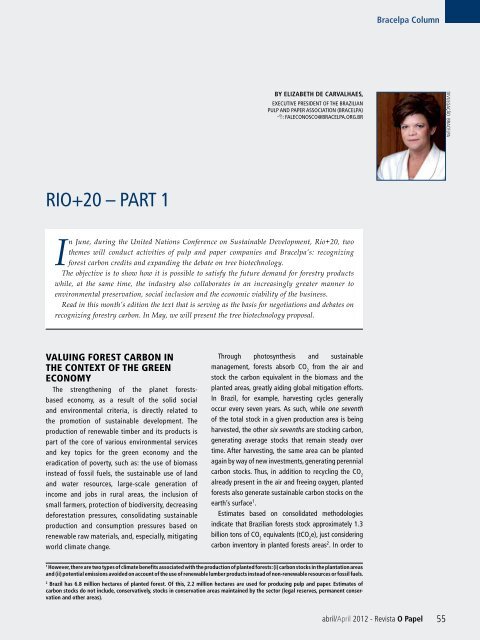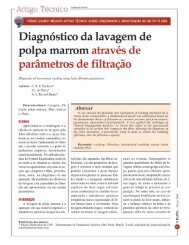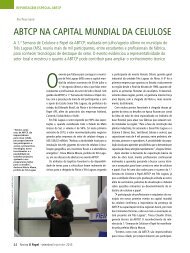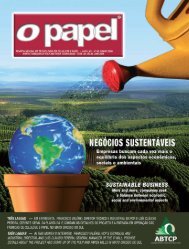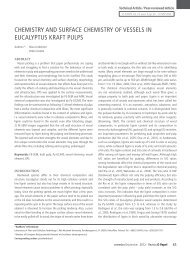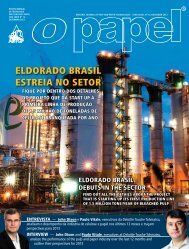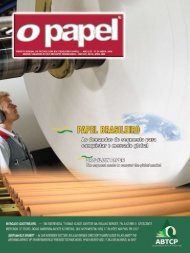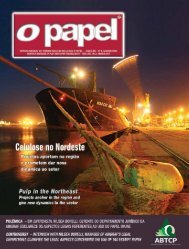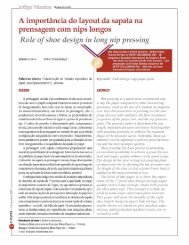PLANO NACIONAL DE RESÃDUOS SÃLIDOS - Revista O Papel
PLANO NACIONAL DE RESÃDUOS SÃLIDOS - Revista O Papel
PLANO NACIONAL DE RESÃDUOS SÃLIDOS - Revista O Papel
Create successful ePaper yourself
Turn your PDF publications into a flip-book with our unique Google optimized e-Paper software.
Bracelpa ColumnBy Elizabeth de Carvalhaes,executive president of the BrazilianPulp and Paper Association (Bracelpa): faleconosco@bracelpa.org.brDivulgação BracelpaRio+20 – Part 1In June, during the United Nations Conference on Sustainable Development, Rio+20, twothemes will conduct activities of pulp and paper companies and Bracelpa’s: recognizingforest carbon credits and expanding the debate on tree biotechnology.The objective is to show how it is possible to satisfy the future demand for forestry productswhile, at the same time, the industry also collaborates in an increasingly greater manner toenvironmental preservation, social inclusion and the economic viability of the business.Read in this month’s edition the text that is serving as the basis for negotiations and debates onrecognizing forestry carbon. In May, we will present the tree biotechnology proposal.Valuing forest carbon inthe context of the greeneconomyThe strengthening of the planet forestsbasedeconomy, as a result of the solid socialand environmental criteria, is directly related tothe promotion of sustainable development. Theproduction of renewable timber and its products ispart of the core of various environmental servicesand key topics for the green economy and theeradication of poverty, such as: the use of biomassinstead of fossil fuels, the sustainable use of landand water resources, large-scale generation ofincome and jobs in rural areas, the inclusion ofsmall farmers, protection of biodiversity, decreasingdeforestation pressures, consolidating sustainableproduction and consumption pressures based onrenewable raw materials, and, especially, mitigatingworld climate change.Through photosynthesis and sustainablemanagement, forests absorb CO 2from the air andstock the carbon equivalent in the biomass and theplanted areas, greatly aiding global mitigation efforts.In Brazil, for example, harvesting cycles generallyoccur every seven years. As such, while one seventhof the total stock in a given production area is beingharvested, the other six sevenths are stocking carbon,generating average stocks that remain steady overtime. After harvesting, the same area can be plantedagain by way of new investments, generating perennialcarbon stocks. Thus, in addition to recycling the CO 2already present in the air and freeing oxygen, plantedforests also generate sustainable carbon stocks on theearth’s surface 1 .Estimates based on consolidated methodologiesindicate that Brazilian forests stock approximately 1.3billion tons of CO 2equivalents (tCO 2e), just consideringcarbon inventory in planted forests areas 2 . In order to1However, there are two types of climate benefits associated with the production of planted forests: (i) carbon stocks in the plantation areasand (ii) potential emissions avoided on account of the use of renewable lumber products instead of non-renewable resources or fossil fuels.2Brazil has 6.8 million hectares of planted forest. Of this, 2.2 million hectares are used for producing pulp and paper. Estimates ofcarbon stocks do not include, conservatively, stocks in conservation areas maintained by the sector (legal reserves, permanent conservationand other areas).abril/April 2012 - <strong>Revista</strong> O <strong>Papel</strong>55


